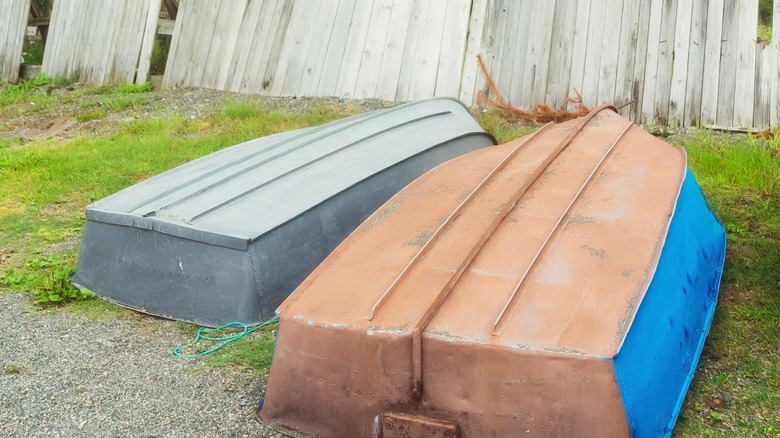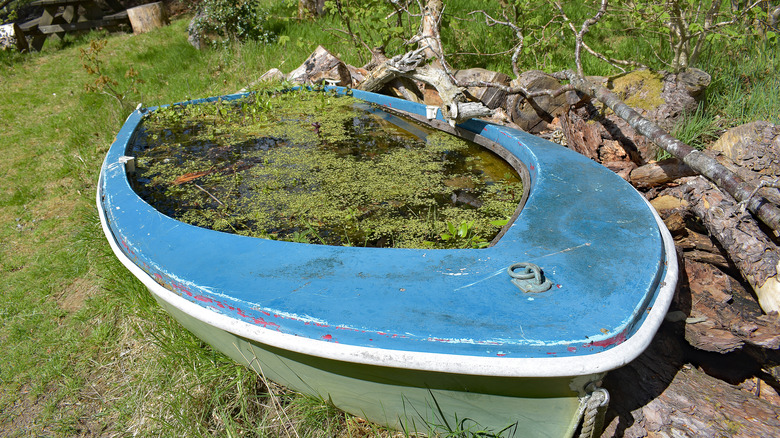Repurpose An Old Boat Into A Stunning Garden Feature With This Creative DIY
We may receive a commission on purchases made from links.
You want a backyard water feature, but you don't have the energy or resources to dig a huge hole. Whether you're a passionate environmentalist wondering how to make an above-ground pond that attracts all types of wildlife or just want to hear the relaxing trickle of a meandering stream while you sip your afternoon tipple, all you need is a boat. Yup, you read that right. Luckily, though, we're talking about a substantial but decidedly economic and surprisingly easy DIY here. Simply take a preloved water-going vessel — be it a canoe, rowboat, small sailboat, or even a gondola — and you can winningly transform it into a backyard garden pond replete with lighting, fountains, aquatic plants, critters, and whatever else your imagination can devise. You'll be shouting "Land ho!" like ye olde sailors in no time!
First, obviously, you can't start without that boat. If you don't have one already, Facebook Marketplace is a great resource for acquiring larger secondhand items at relatively affordable prices. You could also try your local Buy Nothing communities to get something for free — or, at least, only the cost of transportation. Find a group near you on their website. Once home and with your boat in tow, you need to find the ideal spot for your nautical pond. Look for somewhere with shade so the shallow water doesn't heat up too much and make sure you can get at all sides of the boat so you can add in features and conduct ongoing maintenance.
How to turn a shipwreck into a decked-out pond
Boats have peaked hulls that you'll need to make flat before proceeding any further. You could partially bury the hull in gravel or cut some grooves into scrap wood (for example, a 2 x 6 timber board) to create a frame. If you want to paint the outside using a non-toxic, weatherproof exterior paint, do it now! Then, set the boat on some saw horses, scrape or sand off the existing finish, and get brushing or spraying. Choose a moniker for your boat — the title of your grandfather's favorite sea shanty, perhaps — and use paint stencils to add it to the side. Decide, too, if you want to take out the seats. They make nifty shelves for plants, water features, or lights, but the boat pond looks more realistic without them.
You'll also need to seal the inside. This is technically not necessary for most modern crafts — which are typically made from waterproof steel, aluminum, fiber-reinforced plastic (FRP), and polyethylene — unless they're constructed using timber. It will, however, provide a sleeker finish and reduce the possibility of harmful pollutants leaching into the water. One good option is a food-grade epoxy sealer. We recommend the two-gallon kit from East Coast Resin, which is currently available for just over $120 on Amazon. You could also use a pond liner — Lowe's sells a PVC pond liner, suitable for up to 200 gallons of water, for under $50. In both cases, always follow the manufacturer's instructions carefully.
Dive deep into your pond habitat and decor choices
Adding a pond pump reduces algae, attracts birds, and stops mosquitoes laying eggs. Pick up a Vivosun 120-watt submersible water pump cycling 2,700 gallons-per-hour for under $100 from Walmart. Connect the pump to a DIY water feature or store bought fountain for decorative effect and that soothing tinkle of falling water. Once the pump is in, fill the pond with water from your garden hose and wait a couple of days to reduce the chlorine. The environmental benefits of adding a pond to your garden mean embracing all of nature's visitors, including birds, lizards, amphibians, and insects. Place rocks around the pond's edge to give nuthatches some grip and provide bullfrogs with sunbathing spots. You can also add introduced species, like water snails, goldfish, or koi, but note that some are considered invasive.
Water-loving botanicals provide wildlife resources and oxygenate the water. Aquatic plants you should add to your natural water features include water lilies (Nymphaea spp.); wild celery (Vallisneria spp.); canna lilies; North American icons, cattails (Typha latifolia); and common duckweed (Lemna minor). Just like their terrestrial cousins, different pond plants suit different USDA Hardiness Zones so ask at your local nurseries for plants suitable or, better yet, native to the area. Check the USDA's list of Invasive Aquatic Plants for what to avoid, too. Grow them in submerged aquatic planters or float them on the surface. Other landscaping feature options include night lighting, sailing-themed sculptures, or channeling those marina vibes and building a mock wooden pier right up to the side!

